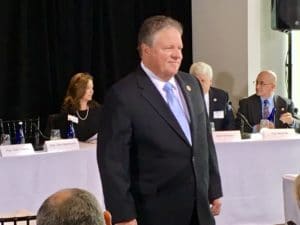History Made as NuScale Files First SMR Application With U.S. Nuke Regulators

Two years ago, NuScale committed to filing a license application for its eponymous SMR design with U.S. regulators by the end of 2016.
Just three months before two company executives used a custom pen on the cover letter of the ~12,000 page design certification application, even NuScale insiders were doubtful that the task could be completed by the self-imposed deadline.
Experienced and jaded observers from outside the company thought the task impossible, given the publicly available information about the status of the effort.
The final actions required to complete and check the document were finished a couple of hours after the famous New Year’s Eve ball had dropped in Times Square.
But NuScale is, and always has been, a West coast company. By the clock in the conference room, the DCA was signed with nearly an hour to spare before 2016 ended.
In an interview, Chief commercial officer Mike McGough described the scene in the Corvallis, Ore., conference room where a small signing ceremony was conducted.
Tired but happy and legitimately proud faces gathered around COO and chief nuclear officer Dale Atkinson and vice president Tom Bergman to witness their signing of the letter that formally requested the U.S. Nuclear Regulatory Commission to review, approve and grant a standard design certification for the NuScale design.
“As you recall, we had the NRC in to conduct a DCA readiness assessment in September,” McGough said.
“When they departed, they gave us a list of 85 items where they felt that we had provided incomplete information that might prevent docketing,” he continued. “Our DCA submission includes a response matrix listing every one of those 85 items and what we did to address the concern.”
On the morning of Jan. 12, company executives piled into a van for the short trip from a Washington, D.C., hotel to NRC headquarters in Rockville, Md.
After hand delivering the DCA and supporting documentation, they held a press conference with brief remarks by company executives, elected officials and nuclear industry leaders at the Newseum near Capitol Hill.
McGough and I spoke about the company’s progress several times during the month of December. The NuScale official repeatedly emphasized that the company had numerous protocols in place to ensure that the submission would be high quality and complete, even if the decision had to be made to miss the self-imposed deadline.
Recent history of DCA submissions at the NRC have shown that there are severe cost, schedule and credibility issues associated with an incomplete submission.
McGough said that his company’s leaders were ready to take several weeks to a few months longer if needed to avoid a docket rejection and DCA resubmission that might require another year or more of effort before getting to the point where the NRC began the review.
Aside: Following NuScale’s press conference announcing the DCA submittal, I spoke with John Hopkins, NuScale’s CEO. He reiterated the company’s firm commitment to submit a complete, high quality DCA as a higher priority than one that met a self-imposed deadline.
He also expressed his appreciation and gratitude to the people who worked so diligently to make the application both timely and complete. He told me that the Fluor board was impressed that a nuclear project met a deadline; it was a relatively rare event. That reinforced their confidence in NuScale designers and managers. End Aside.
The current expectation is that the agency will take about two months to review the application and determine if it is complete or if additional information is needed before the staff can begin its work that, under a recently refined schedule, is projected to take three and a half years.
UAMPS Is First Customer
NuScale’s application provides complete technical details for the standard plant design, which consists of 12 identical modules that could each be a standalone 50 MWe power plant.
Each module has a reactor heat source that uses light water circulated without any pumps to transfer fission heat from the reactor, an integral steam generator and pressurizer, a sealed containment vessel and a complete Rankine cycle steam plant.
All 12 modules will be installed inside a common pool and will be controlled from a single control room.
The modules are sized so they can be completely manufactured and delivered to a site ready to be installed and connected.
This concept provides economy of series production, scalabil- ity and maintenance exibility that is impossible in monolithic power plants designed to produce 1,000 or more MWe per unit.
The first commercial NuScale power plant will be built on a site within the reservation of the Idaho National Laboratory.
It will be owned by the Utah Associated Municipal Power Systems (UAMPS), whose member companies will use the 600 MWe of clean electricity from the facility to supply retail and commercial customers in their service territories. UAMPS has a target date for commercial operation by the end of 2026.
Energy Northwest, an experienced nuclear plant operating company, will operate and maintain the plant for UAMPS.
Primary Funder Is Fluor
The NuScale power module evolved from a design first conceived in 2000 by Dr. Jose Reyes while working as a nuclear engineering professor at Oregon State University. OSU continues to play an important role in hosting several testing facilities and providing a strong pipeline of engineers.
NuScale started pre-application reviews with the NRC in 2008. The firm has purchased 43,000 hours of professional staff time at a cost of more than $11 million to resolve concerns about the design approach and safety case.
The company has also invested in more than 2,000,000 staff hours supplied by a staff of more than 800 people. NuScale worked with more than 50 vendor partners to design and test components, conduct full system tests and develop licensing documentation.
In 2013, the SMR designer competed for and won a grant from the Department of Energy that provided $217 million. NuScale investors have matched those government funds — and then some — to pay for design and licensing efforts.
In 2011, Fluor (FLR:NYSE), the giant multinational construction and contracting company, purchased a majority of the company’s shares and has been the primary source of funds for the project.
Fluor has also been a major participant in the design effort and the establishment of the supply chain for the unique components that form the plant.
Note: A version of the above was first published in Fuel Cycle Week, issue number 690 dated January 12, 2017. It is republished here with permission.



“The current expectation is that the agency will take about two months to review the application and determine if it is complete or if additional information is needed before the staff can begin its work that, under a recently refined schedule, is projected to take three and a half years.”
Would this mean that a unit or unit(s) of the 12 modules could possibly be complete before Vogtle? Time is money and reducing assembly time by such a factor is a strong selling point.
I don’t think so. If the 3 1/2 year NRC effort results in a COL, then you have a “paper reactor” with a license, and the real work can begin.
And the “paper reactor” can still be subject to gyrations, particularly when the region and HQ contradict each other.
“The firm has purchased 43,000 hours of professional staff time at a cost of more than $11 million to resolve concerns about the design approach and safety case.”
I guess I misunderstood. I thought the NRC had already invested the 43,000 hours. That’s about 21 people full time for a year. Does any other industry require this level of review effort by the government?
@Eino
Just to be clear – NuScale has already purchased the 43,000 hours and the NRC has already delivered them in the process of pre-application coordination and review.
The clock hasn’t even started yet for the design certification review. That one will probably take 4-10 times as much time and money.
Not quite as historic, somewhat off topic, but noteworthy nevertheless … the NRC finally, once again, has a nuclear engineer for its chairman.
And this only a week into the new administration.
Thanks Brian. Closely kept secret, but Mr. Google finally turned up a story at Platts: http://www.platts.com/latest-news/electric-power/washington/us-nrcs-svinicki-appointed-chairman-effective-21720968
Apart from a minor clash of symbols, my question is whether Ms Svinicki’s appointment will make any real difference over Mr. Burns. Svnicki is an ex-DoD NE with 10 years experience as senate aid, including to senators Warner and McCain. Burns is a lawyer with experience OECD Nuclear Agency and 30 years at NRC, including 3 as General Counsel.
I don’t personally know any more of either; superficially they both appear very well qualified. Do you know if there is anything here beyond partisan politics?
The ANS website had a news item on it.
“Svnicki is an ex-DoD NE”
She’s ex-DOE, not DOD.
I’ve heard Svinicki speak. She’s rather soft-spoken, but I think she will make a fine chairman.
“Do you know if there is anything here beyond partisan politics?”
How about seniority? Svinicki has been on the Commission much longer than the other two members.
I don’t have anything against a lawyer being on the Commission. I think that legal expertise is quite valuable in a regulatory setting. Nevertheless, nuclear power, by its very nature, is highly technical. Therefore, I prefer to see someone with a relevant technical background leading the Commission, especially during an emergency situation, when the Chairman has to act without the rest of the Commission (e.g., how Chairman Jaczko acted immediately following the Fukushima accident).
Thanks. Albeit — arguably — Mr. Jaczko might have taken 30 minutes or so to ask of his technical colleagues. It’s not clear the Chairman was required to speak in haste.
According to what I’ve heard, Jaczko took measures to keep the other Commissioners out.